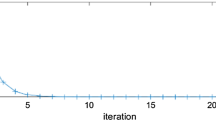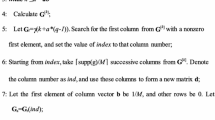Abstract
The discrete Gabor transform (DGT) is an important and widely used time–frequency analysis tool in signal processing. In this paper, a sparse time–frequency representation (TFR) method based on the DGT is studied using mixed \(\ell _{1/2}\)–\(\ell _2\) norm regularization which can overcome the over-sparse problem and permit a better sparsity and stability. Because the width of the window function in the DGT directly affects the time–frequency resolution and concentration of the Gabor spectrum, an adaptive optimal window width (AOWW) selection algorithm based on information entropy theory can be applied to search for the optimal width in the DGT. In this paper, the traditional DGT is converted into a constraint optimization problem by minimizing a mixed \(\ell _{1/2}\)–\(\ell _2\) norm sparse constraint of the Gabor coefficients. The numerical experimental results show that the proposed sparsity-based TFR based on the conventional DGT is an effective and powerful tool for analyzing and processing nonstationary signals, obtaining a higher time–frequency concentration and sparsity of the Gabor TFR of a given signal.


















Similar content being viewed by others
References
A. Akan, L.F. Chaparro, Multi-window Gabor expansion for evolutionary spectral analysis. Signal Process. 63(3), 249–262 (1997)
J. Akhtar, K.E. Olsen, Sparse frequency extrapolation of spectrograms. in 2017 25th European Signal Processing Conference (EUSIPCO). IEEE (2017), pp. 1135–1139
P. Balazs, M. Dörfler, F. Jaillet, Theory, implementation and applications of nonstationary Gabor frames. J. Comput. Appl. Math. 236(6), 1481–1496 (2011)
M.J. Bastiaans, Gabor’s expansion of a signal into Gaussian elementary signals. Opt. Eng. 68(4), 538–539 (1980)
P. Busch, T. Heinonen, P. Lahti, Heisenberg’s uncertainty principle. Phys. Rep. 452(6), 155–176 (2013)
E.J. Candès, J. Romberg, T. Tao, Robust uncertainty principles: exact signal reconstruction from highly incomplete frequency information. IEEE Trans. Inf. Theory 52(2), 489–509 (2006)
E. Cands, J. Romberg, Sparsity and incoherence in compressive sampling. Inverse Probl. 23(3), 969–985(17) (2006)
L. Cohen, Time–frequency distributions—a review. Proc. IEEE 77(7), 941–981 (1989)
I. Daubechies, R. Devore, M. Fornasier et al., Iteratively reweighted least squares minimization for sparse recovery. Commun. Pure Appl. Math. 63(1), 1–38 (2010)
N. Delprat, Global frequency modulation laws extraction from the Gabor transform of a signal: a first study of the interacting components case. IEEE Trans. Speech Audio Process. 5(1), 64–71 (1997)
D.L. Donoho, Compressed sensing. IEEE Trans. Inf. Theory 52(4), 1289–1306 (2006)
M. Dörfler, E. Matusiak, Nonstationary Gabor frames-existence and construction. Int. J. Wavelets Multiresolut. Inf. Process. 12(3), 1481–1496 (2014)
M. Elad, M.A.T. Figueiredo, Y. Ma, On the role of sparse and redundant representations in image processing. Proc. IEEE 98(6), 972–982 (2010)
E. Erelebi, Speech enhancement based on the discrete Gabor transform and multi-notch adaptive digital filters. Appl. Acoust. 65(8), 739–762 (2004)
J. Florent, Time–frequency jigsaw puzzle: adaptive multiwindow and multilayered Gabor expansions. Int. J. Wavelets Multiresolut. Inf. Process. 5(02), 293–315 (2009)
D. Gabor, Theory of communication. J. Inst. Electr. eng. 93(3), 429–457 (1946)
N. Holighaus, Structure of nonstationary Gabor frames and their dual systems. Appl. Comput. Harmonic Anal. 37(3), 442–463 (2013)
L. Hui, Z. Qingfu, X. Zong-Ben, A preference-based multiobjective evolutionary approach for sparse optimization. IEEE Trans. Neural Netw. Learn. Syst. 29(5), 1716–1731 (2018)
S.D. Li, Discrete multi-Gabor expansions. IEEE Trans. Inf. Theory 45(6), 1954–1967 (1999)
Q.F. Lian, J. Gong, M.H. You, Time-domain characterization of multiwindow Gabor systems on discrete periodic sets. Indian J. Pure Appl. Math. 44(1), 47–76 (2013)
T. Liang, H.K. Kwan, Noise reduction for NMR FID signals via oversampled real-valued discrete Gabor transform. IEICE Trans. Inf. Syst. 88–D(7), 1511–1518 (2005)
C. Lu, S. Joshi, J.M. Morris, Parallel lattice structure of block time-recursive generalized Gabor transforms. Signal Process. 57(2), 195–203 (1997)
B.S. Manjunath, W.Y. Ma, Texture features for browsing and retrieval of image data. IEEE Trans. PAMI 18(8), 837–842 (1996)
J.M. Morris, Y. Lu, Discrete Gabor expansion of discrete-time signals in \(\ell ^2(z)\) via frame theory. Signal Process. 40(2–3), 155–181 (1994)
I. Orović, S. Stanković, M. Amin, Compressive sensing for sparse time–frequency representation of nonstationary signals in the presence of impulsive noise. in Compressive Sensing II, vol. 8717. International Society for Optics and Photonics (2013), p. 87170A
M. Öztürk, A. Akan, Y. Çekiç, A robust image watermarking in the joint time–frequency domain. Indian J. Pure Appl. Math. 2010(1), 1–9 (2010)
S.C. Pei, S.G. Huang, STFT with adaptive window width based on the chirp rate. IEEE Trans. Signal Process. 60(8), 4065–4080 (2012)
S. Qian, D. Chen, Discrete Gabor transforms. IEEE Trans. Signal Process. 41(7), 2429–2438 (1993)
S. Qiu, H.G. Feichtinger, Discrete Gabor structures and optimal representation. IEEE Trans. Signal Process. 43(10), 2258–2268 (1995)
E. Sejdić, I. Djurović, J. Jiang, Time–frequency feature representation using energy concentration: an overview of recent advances. Digit. Signal Process. 19(1), 153–183 (2009)
E. Sejdić, I. Orović, S. Stanković, Compressive sensing meets time–frequency: an overview of recent advances in time–frequency processing of sparse signals. Digit. Signal Process. 77, 22–35 (2018)
L. Stanković, A measure of some time–frequency distributions concentration. Signal Process. 81(3), 621–631 (2001)
D.F. Stewart, L.C. Potter, Computationally attractive real Gabor transforms. IEEE Trans. Signal Process. 43(1), 77–84 (1995)
T. Strohmer, Numerical algorithms for discrete Gabor expansions, Gabor Analysis and Algorithms (Springer, Berlin, 1998), pp. 267–294
M. Szyper, New time domain window. Electron. Lett. 31(9), 707–708 (1995)
L. Tao, G.H. Hu, H.K. Kwan, Multiwindow real-valued discrete Gabor transform and its fast algorithms. IEEE Trans. Signal Process. 63(20), 5513–5524 (2015)
D.F. Walnut, Continuity properties of the Gabor frame operator. J. Math. Anal. Appl. 165(2), 479–504 (1992)
J. Wexler, S. Raz, Discrete Gabor expansions. Signal Process. 21(3), 207–220 (1990)
W.J. Williams, A.O. Hero, Uncertainty, information, and time–frequency distributions. Proc. SPIE—Int. Soc. Opt. Eng. 1566, 144–156 (1991)
F.C. Xing, Investigation on solutions of cubic equations with one unknown. J. Cent. Univ. Natl. 12(3), 207–218 (2003)
Z.B. Xu, X.Y. Chang, F.M. Xu, H. Zhang, \(\ell _{1/2}\) regularization: a thresholding representation theory and a fast solver. IEEE Trans. Neural Netw. Learn. Syst. 23(7), 1013–1027 (2012)
Z.B. Xu, H. Liang, Y. Wang, H. Zhang, Representative of \(\ell _{1/2}\) regularization among \(\ell _q (0 < q < 1)\) regularizations: an experimental study based on phase diagram. Acta Automat. Sin. 38(7), 1225–1228 (2012)
L. Zhu, Y. Hao, Y. Song, \({L_{1/2}}\) norm and spatial continuity regularized low-rank approximation for moving object detection in dynamic background. IEEE Signal Process. Lett. 25(1), 15–19 (2018)
M. Zibulski, Y.Y. Zeevi, Gabor representation with oversampling. Proc. SPIE—Int. Soc. Opt. Eng. 1818, 976–984 (1992)
M. Zibulski, Y.Y. Zeevi, Oversampling in the Gabor scheme. IEEE Trans. Signal Process. 41(8), 2679–2687 (1993)
M. Zibulski, Y.Y. Zeevi, Discrete multiwindow Gabor-type transforms. IEEE Trans. Signal Process. 45(6), 1428–1442 (1997)
T.P. Zielinski, Joint time–frequency resolution of signal analysis using Gabor transform. IEEE Trans. Instrum. Meas. 50(5), 1436–1444 (2001)
Acknowledgements
The authors would like to express our sincere gratitude to the anonymous referees for their constructive comments. This work was supported in part by the National Natural Science Foundation of China under Grant No. 61301295, the Anhui Provincial Natural Science Foundation under Grant No. 1708085MF151, the Natural Science Foundation for the Higher Education Institutions of Anhui Province under Grant No. KJ2018A0018, and the Natural Science Foundation of Anhui Science and Technology University under Grant No. XWYJ201802.
Author information
Authors and Affiliations
Corresponding author
Additional information
Publisher's Note
Springer Nature remains neutral with regard to jurisdictional claims in published maps and institutional affiliations.
Rights and permissions
About this article
Cite this article
Li, R., Zhou, J. Sparse Gabor Time–Frequency Representation Based on \(\ell _{1/2}\)–\(\ell _2\) Regularization. Circuits Syst Signal Process 38, 4700–4722 (2019). https://doi.org/10.1007/s00034-019-01077-2
Received:
Revised:
Accepted:
Published:
Issue Date:
DOI: https://doi.org/10.1007/s00034-019-01077-2




